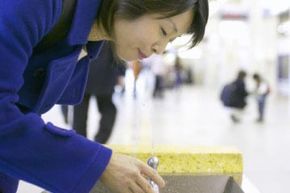In the summer of 1973, a trio of astronauts aboard Skylab -- the United States' first-ever space station -- used air testing instruments to see what they would be breathing during their two-month stay in space. The results were worrying: Skylab's air was filled with trace amounts of more than 100 harmful chemicals.
The space station was made from some of the world's most cutting-edge synthetic materials: plastics, polymers and resins. But while processed materials make for good space stations, they make for lousy air. The materials were emitting small amounts of toxic gas, a phenomenon known as "off-gassing." It's not like the Skylab astronauts could open a window, so for their next 58 days in space, the astronauts simply had to breathe in a swamp of carcinogenic chemicals.
Advertisement
A few hundred miles below, earthlings were having a similar problem. In the face of skyrocketing energy costs during the late 1970s, office buildings in the United States were being built to much higher environmental standards. Rather than working in drafty brick and steel structures, Americans were now going to work in well-insulated office buildings. The buildings were better on heating costs, but their stale, recirculated air was a trap for off-gassed chemicals that caused office workers to develop itchy eyes, skin rashes, drowsiness and breathing problems. Soon, about 30 percent of office buildings were giving workers what came to be known as "sick building syndrome" [source: Environmental Protection Agency].
In the late 1980s, NASA decided to tackle the problem of indoor air quality by calling in Bill Wolverton, an environmental scientist who had done cleanup work for the U.S. military. Equipped with a rich background in plants, Wolverton settled on the relatively simple solution that indoor air quality could improve with a little vegetation. Plants like peace lilies and bamboo shoots looked great in a living room, and Wolverton was sure they could also neutralize toxic gas.
To test Wolverton's theory, NASA engineers put together the BioHome, a heavily-insulated structure about the size of a mobile home built almost entirely from synthetic materials. The BioHome's plastic walls off-gassed so heavily that anybody walking inside was immediately stricken with burning eyes and breathing problems. That is, until engineers crammed the structure with houseplants. Within days, they found, the structure's interior was as fresh as a daisy.
NASA published its results, and offices around the world soon were using indoor foliage to stave off employee headaches and skin rashes.
Keep reading to find out how NASA used bits of silver to deliver fresh water to moon astronauts.
Advertisement


